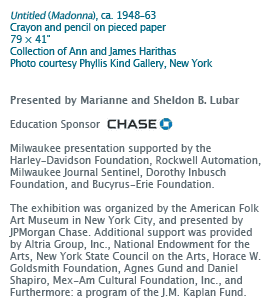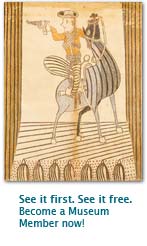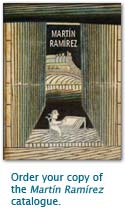



October 6, 2007–January 13, 2008About the exhibitionThis exhibition is dedicated to the family of Martín Ramírez One of the self-taught masters of twentieth-century art, Martín Ramírez created some three hundred artworks of remarkable visual clarity and expressive power within the confines of DeWitt State Hospital, in Auburn, California, where he resided for the last fifteen years of his life. Ramírez’s complexly structured works are characterized by skillful and inventive draftsmanship and extraordinary spatial manipulations. The artist employs a diverse repertoire of imagery, fusing elements of Mexican and American culture, the environment of confinement, and his experience as a Mexican living in poverty and exile in the United States. Martín Ramírez (1895–1963) left his native Mexico in 1925 with the aim of finding work in the United States and supporting his wife and children back home in Jalisco. Political and religious struggles in Mexico that directly affected the welfare of his family, as well as the economic consequences of the Great Depression, left him homeless and without work on the streets in northern California in 1931. Unable to communicate in English and apparently confused, he was soon picked up by the police and committed to a psychiatric hospital, where he would eventually be diagnosed as a catatonic schizophrenic. Ramírez spent the second half of his life in a succession of mental institutions in California. During those thirty-two years, Ramírez hardly spoke to anyone. However, some time in the mid-1930s, he began to draw. In the early 1950s, Tarmo Pasto, a visiting professor of psychology and art at Sacramento State University, saw some of Ramírez’s drawings in the ward at DeWitt State Hospital and recognized their singular artistic value. Pasto not only made Ramírez a subject of his research into mental illness and creativity but also started to supply him with materials, collect his drawings, and, by organizing public exhibitions, introduce his artwork to the public. During the more than five decades since the fortuitous meeting between Pasto and Ramírez, much has been speculated about the artist’s life and work. His oeuvre forms an impressive map of a life shaped by immigration, poverty, institutionalization, and most of all art. Migration and memory seem to factor strongly in every image. His compositions document his life experiences; favored images of Mexican Madonnas, animals, cowboys, trains, and landscapes merge with scenes of American culture. Ramírez never seemed to tire of his preferred topics, yet within his limited set of subjects he demonstrates an amazing range of expression. While his singularly identifiable figures, forms, line, and palette reveal an exacting and highly defined vocabulary, they also show Ramírez to be an adventurous artist, exhibiting remarkably creative explorations through endless variations on his themes. Brooke Davis Anderson, Curator, American Folk Art Museum Read the complete Folk Art Magazine article by Brooke Davis Anderson as excerpted in the October issue of the Member newsletter. What the critics are saying:Peter Schjeldahl for the New YorkerRoberta Smith for the New York Times Jerry Saltz for the Village Voice Ariella Budick for Newsday Dan Avery for Time Out NY Alejandra Villasmil for El Diario (Espanol)
|
© Copyright 2007 Milwaukee Art Museum

